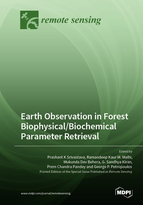Earth Observation in Forest Biophysical/Biochemical Parameter Retrieval
A special issue of Remote Sensing (ISSN 2072-4292). This special issue belongs to the section "Forest Remote Sensing".
Deadline for manuscript submissions: closed (30 June 2021) | Viewed by 42512
Special Issue Editors
Interests: hyperspectral remote sensing; soft computing
Special Issues, Collections and Topics in MDPI journals
Interests: ecological climatology; biophysical variables; spatial biodiversity; forest cover dynamics
Special Issues, Collections and Topics in MDPI journals
Interests: remote sensing applications in forestry & agriculture; hyperspectral remote sensing
Special Issues, Collections and Topics in MDPI journals
Interests: earth observation; modeling; land surface interactions; soil moisture; evapotrasnpiration; land use/cover mapping; change detection; natural hazards; floods; wildfires; sensitivity analysis; soil vegetation atmosphere transfer modeling; operational products benchmarking
Special Issues, Collections and Topics in MDPI journals
Special Issue Information
Dear Colleagues,
Forests, which occupy about one-third of the terrestrial surface of Earth, play an indispensable role in monitoring global climate change and ecosystem dynamics. The health of forests has been affected in recent years by various stress factors, such as forest fragmentation and deforestation, biodiversity loss, climate change, invasive species, drought, and unsustainable management. In this situation, quantitative appraisal of biophysical and biochemical parameters is imperative since it can provide a direct assessment and prediction of forest health and sustainability.
Earth Observation aids in the spatiotemporally explicit retrieval of forest biophysical and biochemical parameters in both the optical and microwave domain. This information can be utilized to monitor and forecast short- and long-term changes in forest ecosystems that occur due to different factors. Different methods have been explored to retrieve forest biophysical/biochemical parameters, such as parametric regression (including vegetation indices, shape indices, and spectral transformations), nonparametric regression (including linear and nonlinear machine learning regression algorithms), physically based methods (including inversion of radiative transfer models (RTMs) using numerical optimization and look-up table approaches), and hybrid regression methods (that combine RTM simulations with machine learning regression methods).
This Special Issue will cover the evaluation of different techniques for the retrieval of different biophysical/biochemical parameters using available Earth Observation data. We invite you to contribute a research article to this Special Issue on one of the following topics:
- retrieval of biophysical parameters, viz. LAI, vegetation water content, height, biomass, DBH, etc.;
- measurement of biochemical parameters, viz. chlorophyll, pigments, etc.;
- radiative transfer models in the retrieval of biophysical/biochemical parameters;
- establishment of relationships between in situ measured biophysical/biochemical parameters and ground-measured data;
- airborne or spaceborne hyperspectral data in the retrieval of biophysical/biochemical parameters;
- LiDAR and RADAR remote sensing in the estimation of biophysical variables;
- relation of biophysical/biochemical parameters to climatic factors;
- biophysical/biochemical parameter retrieval from an Unmanned Autonomous Vehicle (UAV).
Dr. Prashant K Srivastava
Dr. Ramandeep Kaur M. Malhi
Dr. Mukunda Dev Behera
Prof. Dr. G. Sandhya Kiran
Dr. Prem Chandra Pandey
Dr. George P. Petropoulos
Guest Editors
Manuscript Submission Information
Manuscripts should be submitted online at www.mdpi.com by registering and logging in to this website. Once you are registered, click here to go to the submission form. Manuscripts can be submitted until the deadline. All submissions that pass pre-check are peer-reviewed. Accepted papers will be published continuously in the journal (as soon as accepted) and will be listed together on the special issue website. Research articles, review articles as well as short communications are invited. For planned papers, a title and short abstract (about 100 words) can be sent to the Editorial Office for announcement on this website.
Submitted manuscripts should not have been published previously, nor be under consideration for publication elsewhere (except conference proceedings papers). All manuscripts are thoroughly refereed through a single-blind peer-review process. A guide for authors and other relevant information for submission of manuscripts is available on the Instructions for Authors page. Remote Sensing is an international peer-reviewed open access semimonthly journal published by MDPI.
Please visit the Instructions for Authors page before submitting a manuscript. The Article Processing Charge (APC) for publication in this open access journal is 2700 CHF (Swiss Francs). Submitted papers should be well formatted and use good English. Authors may use MDPI's English editing service prior to publication or during author revisions.










